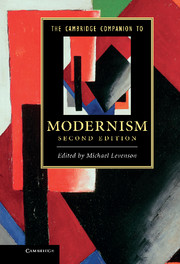Book contents
- Frontmatter
- Introduction
- 1 The metaphysics of Modernism
- 2 The cultural economy of Modernism
- 3 The Modernist novel
- 4 Modern poetry
- 5 Modernism in drama
- 6 Modernism and the politics of culture
- 7 Modernism and religion
- 8 Modernism and mass culture
- 9 Modernism and gender
- 10 Musical motives in Modernism
- 11 Modernism and the visual arts
- 12 Modernism and film
- 13 Modernism and colonialism
- Further reading
- Index
8 - Modernism and mass culture
Published online by Cambridge University Press: 28 September 2011
- Frontmatter
- Introduction
- 1 The metaphysics of Modernism
- 2 The cultural economy of Modernism
- 3 The Modernist novel
- 4 Modern poetry
- 5 Modernism in drama
- 6 Modernism and the politics of culture
- 7 Modernism and religion
- 8 Modernism and mass culture
- 9 Modernism and gender
- 10 Musical motives in Modernism
- 11 Modernism and the visual arts
- 12 Modernism and film
- 13 Modernism and colonialism
- Further reading
- Index
Summary
From its inception Modernism defined itself - and has been defined - by its relationship to mass culture. Aesthetic autonomy, the Modernist ideology that defined art as separate from culture, was a project that emerged unevenly and across most industrializing nations in the nineteenth and twentieth centuries. The distinction between art and mass culture was central to artistic debates over Modernism in Great Britain, and offers an illuminating case study to be pursued within this chapter. Britain experienced rapid industrialization and new media as forces that exaggerated and simultaneously disrupted established class hierarchies. Modernist artists articulated their differences from mass culture to understand and explain themselves as a culturally distinct movement; critics of the period invoked these differences to justify their status as experts prepared to enlighten an under-informed public about Modernism's high purpose; and in recent decades a new generation of critics of British Modernism has distanced itself from artists' and critics' earlier claims of difference from mass culture by depicting Modernism and mass culture as historically related and dialectically interdependent. But whether critics articulate Modernism as separated by a "great divide" from mass culture or as mutually constitutive, they agree that one of the foundational contexts for understanding Modernism is its relationship to mass culture.
- Type
- Chapter
- Information
- The Cambridge Companion to Modernism , pp. 197 - 211Publisher: Cambridge University PressPrint publication year: 2011
- 2
- Cited by



